Try this Japanese egg recipe for tamagoyaki. It’s easy to make, fully customizable, and doesn’t require a special pan. Filled with melting cheese and smoked salmon, it’s rich in umami and perfect for rolling your own Japanese omelet at home.
Jump to Recipe
Tamagoyaki with Fillings: My Easy, Cheesy Version
I first fell in love with tamagoyaki with fillings at my Japanese host family’s home in Gunma. For breakfast, my host mom would roll up layers of egg around melty mozzarella and spicy mentaiko. She knew it was my favorite.
This Japanese egg recipe is my own Western-inspired take on rolled omelets, made with simple ingredients like smoked salmon and cheese. You won’t need any hard-to-find Japanese fillings to make it at home.
Think tamagoyaki is tricky? Let me show you how simple and cheesy it can be. I tested over ten variations to get it just right. After one warm, melty bite, breakfast will never be the same.
Jump to:
- Tamagoyaki with Fillings: My Easy, Cheesy Version
- What is Tamagoyaki (Japanese Rolled Omelet)?
- Recipe at a Glance
- Making Tamagoyaki for the First Time?
- Ingredients
- Can I make tamagoyaki without the pan?
- Which special tamagoyaki pan should I buy?
- Expert Tips on how to make the Best Tamagoyaki with Fillings
- Frequently Asked Questions
- Japanese Eggs - Tamagoyaki with Fillings
What is Tamagoyaki (Japanese Rolled Omelet)?
Tamagoyaki (卵焼き) is a Japanese rolled omelet made by layering thin sheets of egg in a rectangular or square tamagoyaki pan. Unlike the sweet version often served in sushi restaurants, this easy homemade tamagoyaki is savory and can be filled with delicious ingredients like smoked salmon, cheese, or spinach.
There’s also a Korean version of rolled omelets called gyeran mari (계란말이), which I love as well! Unlike tamagoyaki, gyeran mari often includes finely chopped vegetables and does not use dashi. Want to try it? Here’s my easy gyeran mari recipe!
Tamagoyaki vs. Dashimaki Tamago: What’s the Difference?
The terms tamagoyaki and dashimaki tamago are sometimes used interchangeably, but they have key differences:
- Tamagoyaki (卵焼き): A general term for Japanese rolled omelets. It’s typically firm, with a small amount of dashi, soy sauce, or mirin for umami.
- Dashimaki Tamago (だし巻き卵): A softer, more custard-like variation of tamagoyaki with a much higher ratio of dashi.
Tamagoyaki is commonly served in Japanese breakfasts, bento boxes, and sushi restaurants. In contrast, dashimaki tamago, with its softer and more delicate texture, is often featured in kaiseki meals or served at izakayas.
Craving More Japanese Egg Dishes? Try These Next!
🥢 Want a fun twist on tamagoyaki? Try my sweet superfood tamagoyaki! This healthy Japanese breakfast is packed with comforting flavors—oatmeal, crushed almonds, cinnamon, and juicy blueberries—bringing a warm, nutty sweetness to the classic rolled omelet.
🍜 Love ramen eggs? Check out my ajitsuke tamago recipe (ajitama). These soy-marinated eggs are perfect as a ramen topping or high-protein snack.
🍳 More Tamagoyaki Filling Ideas! Looking for more tamagoyaki with authentic Japanese fillings? See all the different tamagoyaki fillings I've tried and loved.
If you need any help, DM me on instagram or leave me a question in the comments below.
❤️ & 🥚 from Japan, Matt
Recipe at a Glance
Cuisine— Japanese Course— Breakfast Dietary Info— Low carb, Keto-friendly Skill Level— Medium
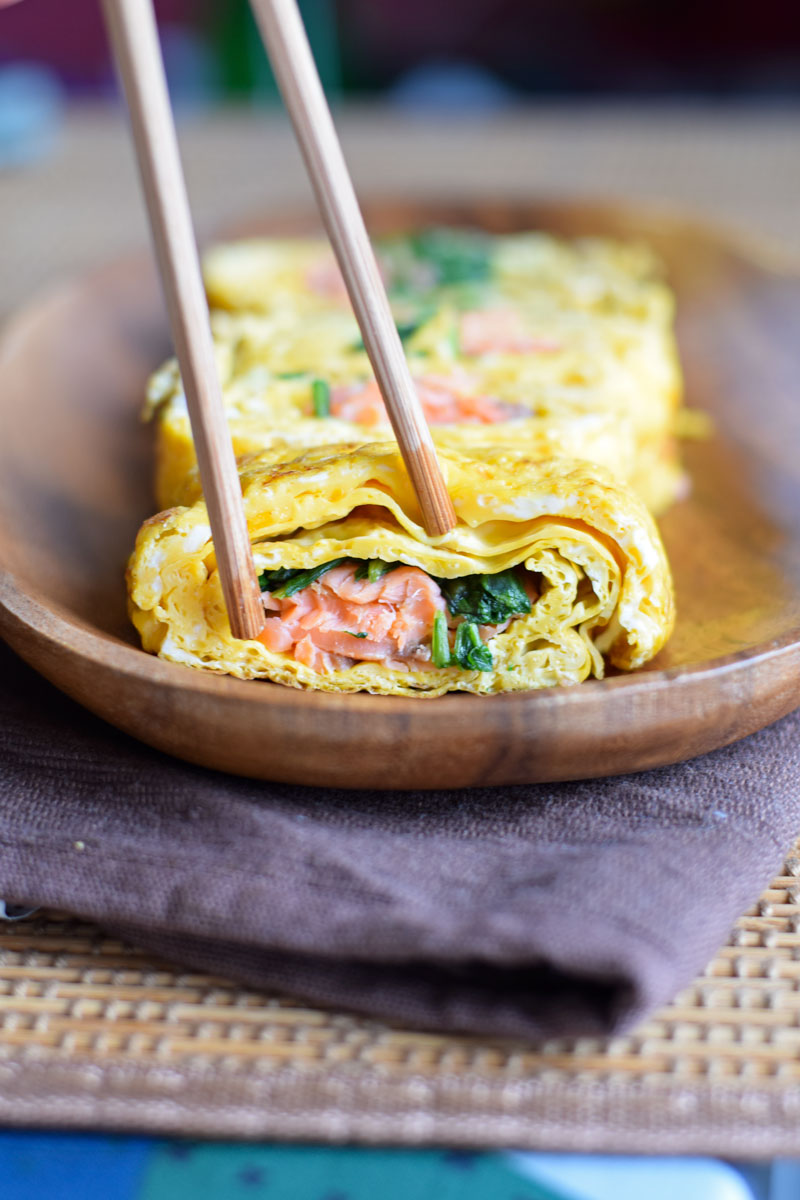
Making Tamagoyaki for the First Time?
If you're new to rolling tamagoyaki, don't worry—it just takes practice and patience! With time, you'll be flipping perfect omelets like a pro.
As a visual learner myself, I found watching “how to make tamagoyaki” videos on YouTube super helpful for mastering the technique.
If you're starting out, check out my video on making basic tamagoyaki without fillings. It’s a simple way to get the hang of it and boost your confidence before experimenting with fillings!
Ingredients
Egg Base: The Foundation of Tamagoyaki
The key to a perfect tamagoyaki starts with the right egg mixture with just right ratios of ingredients.
I use three regular sized eggs. But if you're cooking for more people, you can easily scale up to make multiple omelets one at a time.
A small pinch of sea salt (or kosher salt) enhances the natural umami, while liquid dashi (about 2 tsp) deepens the flavor with a savory, slightly smoky note.
If you don’t have dashi on hand, you can go without. You’ll just lose a bit of that classic Japanese taste.
Fillings: Layers of Flavor in Every Bite
What makes this tamagoyaki stand out is the filling! Instead of the classic plain or slightly sweet version, I’ve opted for a savory, umami-packed combination that melts together beautifully when rolled:
- Smoked Salmon: Adds a rich, slightly salty flavor that pairs perfectly with eggs. I recommend chopping it into smaller pieces so it distributes evenly.
- Spinach: A pop of dark green color and a boost of nutrients! Blanching and squeezing out excess moisture is key to keeping the tamagoyaki from getting watery.
- Mild Blue Cheese: This might not be traditional, but trust me—it works. The bold, creamy, and slightly funky flavor of blue cheese adds an unexpected but delicious contrast. If blue cheese isn’t your thing, you can swap it for cream cheese or shredded mozzarella for a milder touch.
Greasing the Pan: The Key to a Smooth Roll
To get that signature silky surface and prevent sticking, you'll need a little butter or cooking oil. Butter gives the tamagoyaki a richer taste, while a neutral oil (like avocado or vegetable oil) will keep it light.
In Japan, cooking oil is typically used. I'll use grass-fed butter, but this isn't the norm.

Can I make tamagoyaki without the pan?
You can definitely make tamagoyaki without a rectangular tamagoyaki pan! Use a smaller fry pan to prevent the egg layers from spreading too thin. If you use a larger pan, you might need extra egg mixture to create thicker layers that can hold fillings.
Even if you don’t have a small fry pan (about 10 inches), it's worth trying! The rolling technique takes some practice.
If you don’t own a tamagoyaki pan, try making Korean-style tamagoyaki, gyeran mari. The filling is mixed into the beaten egg, and without the added dashi, it’s easier to roll.

Which special tamagoyaki pan should I buy?
If you're a tamagoyaki fan, a rectangular pan is a great investment. You can find one online easily, and I recommend looking for steel versions. I personally use a steel pan from Kappabashi “Kitchen Town” in Tokyo, which I seasoned using a YouTube tutorial.
In Japan, it’s common not to use soap when cleaning these pans, and I follow that practice as well.
For those outside Japan, I ordered a non-stick tamagoyaki pan for my mom from Amazon, and she loves it. If you'd like to avoid non-stick, there’s also an iron version available (though it’s pricier).
Copper tamagoyaki pans, recommended by Japanese food bloggers like Just One Cookbook and Chopstick Chronicles, are a solid choice and available at a reasonable price on Amazon.
If you ready to upgrade, check out Iwachu's cast iron pan. These come from Iwate Prefecture, one of the most famous regions for ironware in Japan.

Expert Tips on how to make the Best Tamagoyaki with Fillings
1. Start with Less Dashi
If this is your first time making tamagoyaki, go easy on the dashi—no more than 2 teaspoons. The more liquid you add, the harder it becomes to roll. Once you get comfortable with the technique, you can gradually increase the dashi for extra umami flavor.
2. Grease the Pan Properly
A well-greased pan is essential for a smooth, even roll. Use a thin layer of butter or neutral oil (like avocado or vegetable oil) before adding each new layer of egg. Too little oil can cause sticking, while too much can make the omelet greasy. Aim for a light, even coating.
3. Practice with a Plain Tamagoyaki First
Rolling tamagoyaki takes practice! If you’re a beginner, start with a plain tamagoyaki (no fillings) to get the hang of layering and rolling before adding ingredients. It took me a few tries before I could roll it smoothly.
4. Choose the Right Utensil for Rolling
Most Japanese chefs use long cooking chopsticks, and now that I’ve practiced, I prefer them too. But if you’re just starting out, a wooden spatula is much easier to handle when flipping and rolling.
5. Cook on Low Heat for Better Control
Keep the heat low, especially when you’re learning. This gives you more control when rolling and helps prevent burning. Taking your time also makes it easier to evenly distribute the fillings without rushing.
Frequently Asked Questions
1. What are Japanese eggs?
Japanese egg recipes that people might not know by name include ajitamago (soft-boiled eggs, often served with ramen), onsen tamago (slow-cooked eggs with a milky texture), and tamagoyaki (Japanese-style rolled omelette).
2. What does tamagoyaki taste like?
Tamagoyaki tastes similar to a regular omelette. Except you'll notice an extra umami flavor from the added dashi soup stock and subtle sweetness from added sugar.
3. What is the difference between tamago and tamagoyaki?
Tamago just means egg in Japanese. Tamagoyaki means Japanese rolled omelette, with or without fillings.
4. Why is tamagoyaki sweet?
Tamagoyaki is typically made with added sugar. Sweetness varies depending on the recipe. Savory tamagoyaki tend to have less sugar. The tamagoyaki served at sushi restaurants tends to be sweeter.
Did you try this recipe? Tag @eyesandhour on Instagram and leave a ⭐️⭐️⭐️⭐️⭐️ rating & comment below!
What’s your favorite tamagoyaki filling? Let me know in the comments!
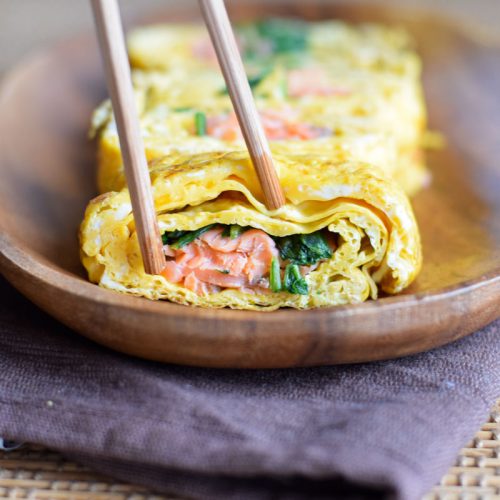
Japanese Eggs - Tamagoyaki with Fillings
Ingredients
- 3 eggs
- 3 pinches salt
- 2 teaspoon liquid dashi
- ¼ cup sliced smoked salmon about 70 grams
- 1 cup chopped spinach
- 3-4 slices blue cheese
- 1-2 teaspoon butter (or cooking oil)
Instructions
Prep- Fillings
- Chop the spinach.
- Sauté spinach in a fry pan on low heat. (no oil)
- Stir spinach with a spatula. Gently cook until soft.
- Set spinach aside. Cover spinach with paper towel. Squeeze out water with hands. Repeat until most of the moisture is removed.
- Use paper towel to remove excess moisture from smoked salmon.
Prep- Eggs
- Crack eggs into a mixing bowl.

- Mix well with a fork or chopsticks.

- Add salt and dashi. Then, stir together.

- Set mixing bowl aside next to your stove top.
Cooking
- Turn on stove burner to low heat.
- Coat tamagoyaki pan with butter. Holding the pan's handle, turn the fry pan back and forth and side to side to ensure all the corners get covered.

- With a fork or chopsticks, put a small amount of egg on the surface of the pan. If the egg sizzles, the pan is hot enough.

- Pour enough egg in pan to make a thin layer. Slightly tilt the pan and forth and side to side so the egg coats the entire bottom of the pan.
- Once the first layer of egg is half cooked, add fillings on top of one another one-third of the layer of egg (in this order: smoked salmon, cheese, spinach). See photo below.

- With a spatula, roll up the tamagoyaki towards you to carefully wrap fillings inside. Keep rolling until you reach the end of the pan closest to you.

- Once completely rolled up, nudge the roll to the far side of the pan, away from you.
- Repeat the process from step 2- recoat the pan with butter, add egg mixture, and roll. Continue this process until you run out of egg. Tip- When adding the second and third layers of egg, gently list the tamagoyaki roll with a spatula so the raw egg can slide underneath the roll and coat the entire pan.

Plating
- Turn off stove. Use the spatula to gently put the tamagoyaki roll on a cutting board.

- Use paper towel to remove some of the moisture from the outside surface of the roll.
- Let cool for a minute or two.
- Use a sharp knife to carefully slice the tamagoyaki roll into 4-5 pieces. Using a sawing motion to cut a line. Then press firmly down with knife.



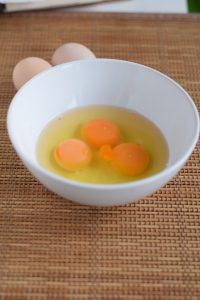

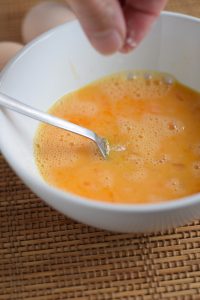




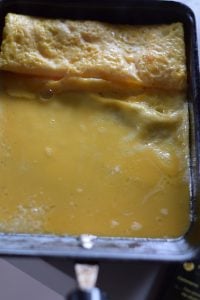
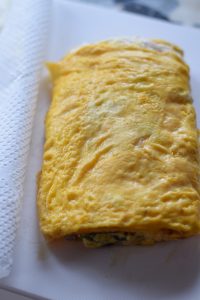

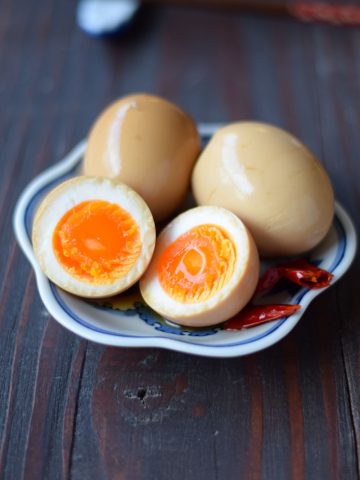
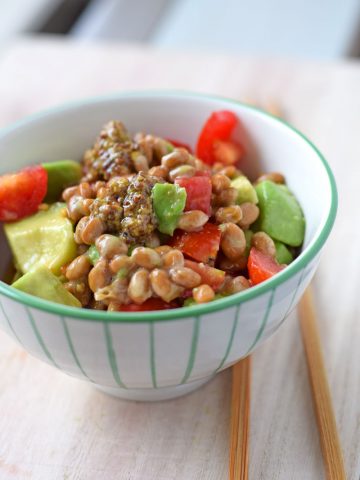
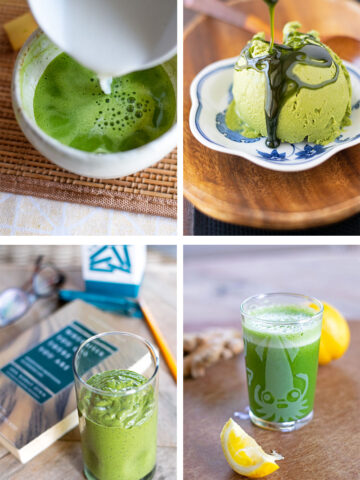





Pris Frank says
A lovely, simple recipe. The technique is really the most important thing here. Thank you! I'm really enjoying your blog. I write recipes too, and your "lesson learned" here really hit close to home... there's 2 recipes that I tried a dozen times already and couldn't (yet) perfect. I won't give up, but I moved on. I see also blogs with recipes so simple that I though nobody would care about... but you are right! I should I go with the flow, and look for wisdom in my peers. Always something new to learn 🙂
Matt says
Thank you so much, Pris! That's so sweet of you to say. After reading your comment about the lesson learned, I had to go back and read what I wrote. The recipe I just finished yesterday, again, was super simple and easy. I'm beginning to learn patience and to just enjoy the process. I've gotten really good at failing too. haha! It's my greatest teacher.
frank says
is the salmon cooked before hand?
Matt says
Hi Frank! I used smoked salmon for this recipe. But I suppose sushi-grade would also work.
I'll have to try it out! Thank you for your comment.